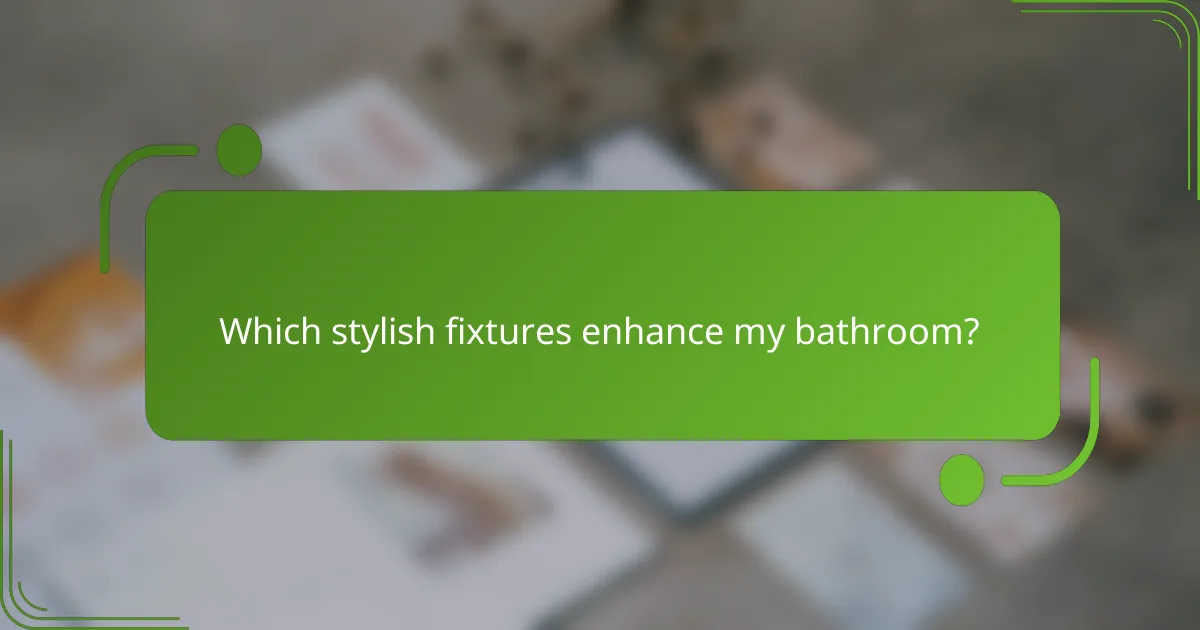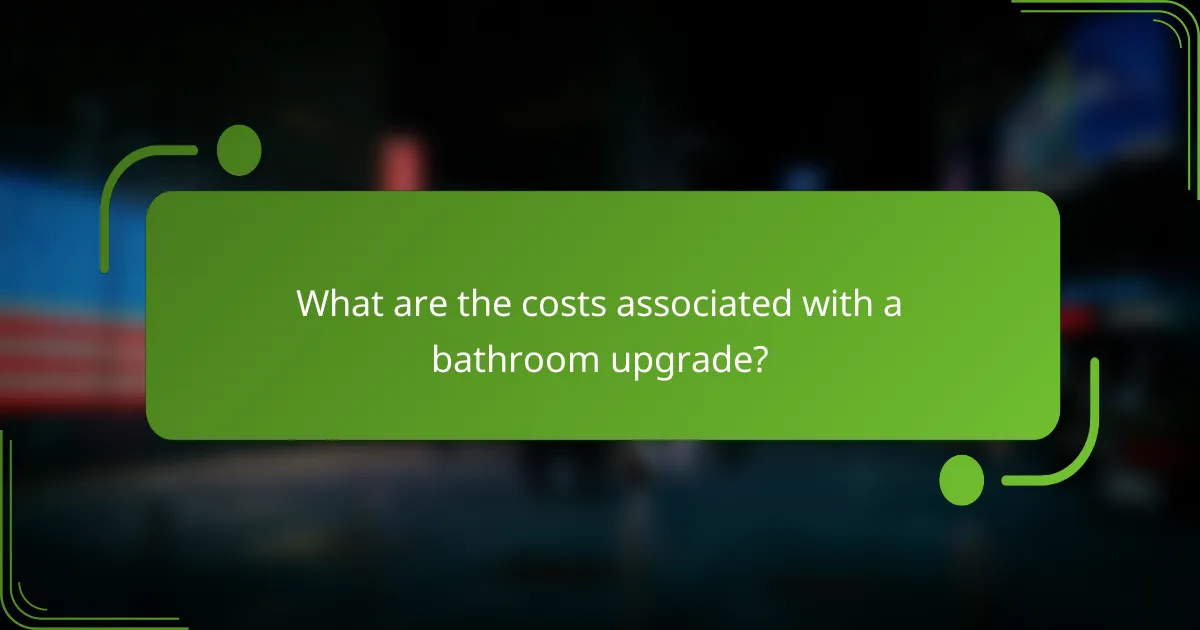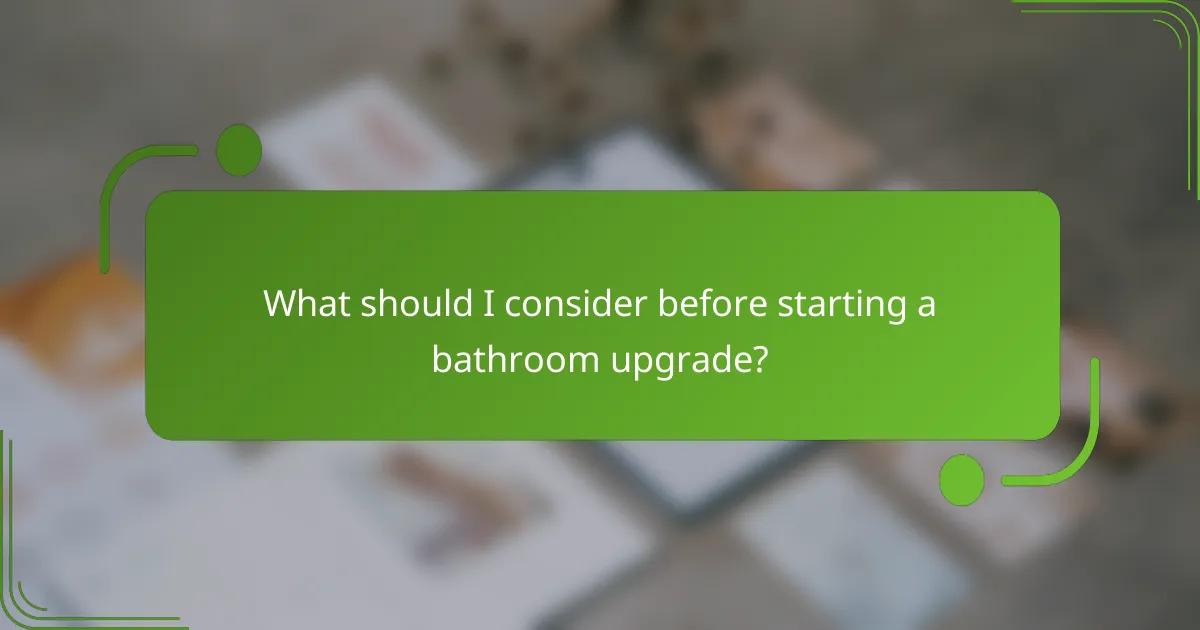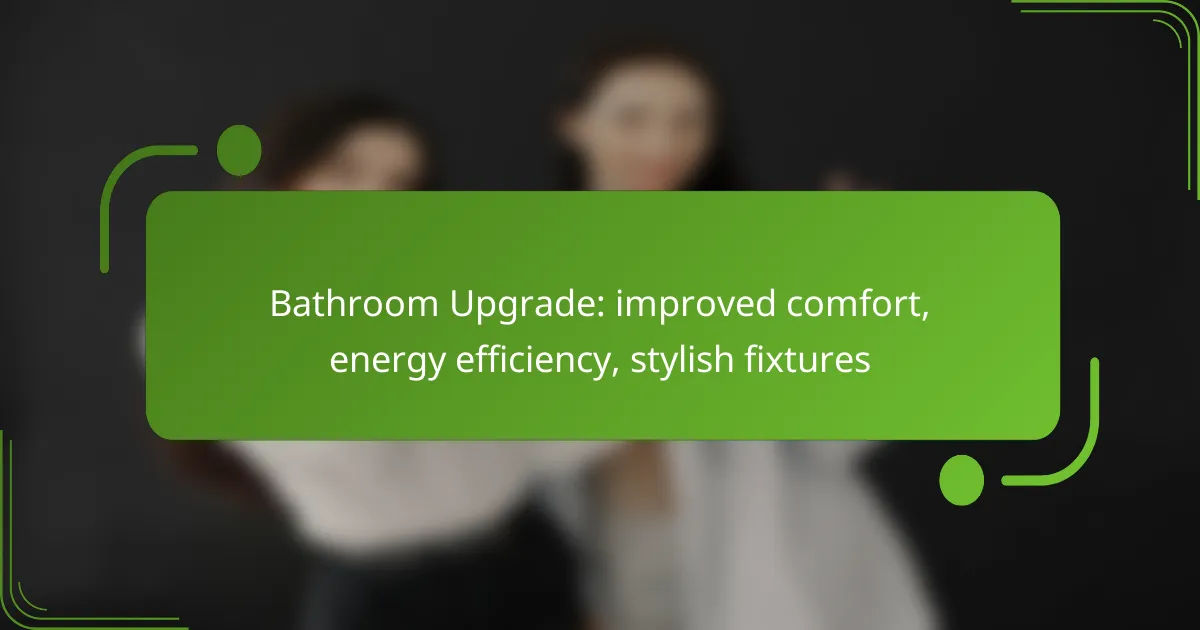Upgrading your bathroom can transform it into a haven of comfort, efficiency, and style. By incorporating thoughtful features that enhance usability and relaxation, you can create a more enjoyable space. Energy-efficient fixtures not only reduce consumption but also elevate the overall aesthetic, while stylish designs add a touch of luxury to your daily routine.

How can I improve comfort in my bathroom?
Improving comfort in your bathroom can be achieved through thoughtful upgrades that enhance usability and relaxation. Consider features that provide warmth, efficiency, and a touch of luxury to create a more enjoyable space.
Heated flooring systems
Heated flooring systems are an excellent way to enhance comfort, especially during colder months. These systems can be electric or hydronic, providing warmth from the ground up, which makes stepping out of the shower or bath much more pleasant.
When considering installation, evaluate the size of your bathroom and the type of flooring you have. Electric systems are typically easier to install in smaller spaces, while hydronic systems may be more cost-effective for larger areas. Expect installation costs to vary widely based on your specific setup.
High-efficiency toilets
High-efficiency toilets (HETs) use significantly less water than traditional models, improving comfort through reduced noise and better performance. These toilets typically use around 1.28 gallons per flush compared to the standard 1.6 gallons.
When selecting a high-efficiency toilet, look for models certified by the Environmental Protection Agency’s WaterSense program. This certification ensures that the toilet meets strict efficiency and performance standards, helping you save on water bills while maintaining comfort.
Luxury showerheads
Luxury showerheads can transform your daily routine into a spa-like experience. Options include rain showerheads, handheld models, and multi-function designs that allow you to customize your water flow and pressure.
When choosing a luxury showerhead, consider the flow rate, which should ideally be under 2.5 gallons per minute to comply with water efficiency standards. Look for features like adjustable settings and easy installation to enhance your comfort without complicating the upgrade process.
Soft-close toilet seats
Soft-close toilet seats prevent slamming and reduce noise, enhancing the overall comfort of your bathroom. These seats feature a mechanism that allows them to close gently and quietly, making them ideal for households with children or multiple users.
Installation is straightforward and typically requires only a few tools. When purchasing, ensure that the seat fits your toilet model and consider materials that are easy to clean and maintain for long-lasting comfort.
Ergonomic vanities
Ergonomic vanities are designed to improve comfort by providing better accessibility and usability. Features may include adjustable heights, ample storage, and easy-to-reach surfaces that cater to users of all ages and abilities.
When selecting an ergonomic vanity, consider the layout of your bathroom and how you use the space. Look for designs that maximize storage while allowing for easy movement, and choose materials that complement your overall bathroom style for a cohesive look.

What energy-efficient upgrades can I make?
Energy-efficient upgrades in your bathroom can significantly reduce water and electricity consumption while enhancing comfort and style. Consider options like low-flow fixtures, LED lighting, water-saving showerheads, and smart thermostats to achieve both savings and improved aesthetics.
Low-flow faucets
Low-flow faucets are designed to reduce water usage without sacrificing performance. These fixtures typically use 1.5 to 2.2 gallons per minute (GPM), compared to standard faucets that can use over 2.5 GPM. By installing low-flow faucets, you can save water and lower your utility bills.
When selecting low-flow faucets, look for models that are WaterSense certified, ensuring they meet efficiency standards. Installation is usually straightforward, making it a practical DIY project for many homeowners.
LED lighting fixtures
LED lighting fixtures are a smart choice for energy efficiency in the bathroom. They consume up to 75% less energy than traditional incandescent bulbs and have a much longer lifespan, often lasting over 25,000 hours. This means fewer replacements and lower energy costs.
Consider replacing existing bulbs with LED options or upgrading to complete LED fixtures. Look for dimmable options to enhance ambiance while still being energy-efficient. Remember to check for the ENERGY STAR label for guaranteed performance.
Water-saving showerheads
Water-saving showerheads can significantly reduce water consumption while maintaining a satisfying shower experience. These fixtures typically use 1.5 to 2.0 GPM, compared to standard models that can exceed 2.5 GPM. This upgrade can lead to substantial water savings over time.
Choose showerheads that have a good balance of flow rate and pressure. Features like multiple spray settings can enhance comfort while still being efficient. Look for WaterSense certification to ensure compliance with efficiency standards.
Smart thermostats
Smart thermostats can optimize your bathroom’s heating and cooling, improving energy efficiency. These devices learn your schedule and preferences, allowing for automatic adjustments that save energy when the bathroom is not in use. This can lead to noticeable reductions in heating bills.
When selecting a smart thermostat, ensure it is compatible with your existing heating system. Features like remote access and energy usage reports can help you monitor and adjust settings for maximum efficiency. Consider models that integrate with home automation systems for added convenience.

Which stylish fixtures enhance my bathroom?
Stylish fixtures can significantly elevate the aesthetic and functionality of your bathroom. Consider modern sink designs, wall-mounted faucets, freestanding bathtubs, and designer mirrors to create a comfortable and energy-efficient space.
Modern sink designs
Modern sink designs focus on sleek lines and innovative materials, enhancing both style and usability. Options like vessel sinks, undermount sinks, and integrated sinks can complement various bathroom themes.
When selecting a sink, consider the size and layout of your bathroom. A compact vessel sink may work well in smaller spaces, while a larger undermount sink can provide ample surface area for daily tasks.
Wall-mounted faucets
Wall-mounted faucets are a stylish choice that saves counter space and adds a contemporary touch. They can be installed at various heights, making them suitable for different user preferences.
Ensure compatibility with your sink and plumbing before installation. Opt for models with water-saving features to enhance energy efficiency while enjoying a modern look.
Freestanding bathtubs
Freestanding bathtubs serve as a luxurious centerpiece in any bathroom. They come in various shapes and materials, allowing you to choose one that fits your design vision and comfort needs.
Consider the space available and the bathtub’s weight when selecting a model. Acrylic tubs are lighter and easier to install, while cast iron options offer durability and heat retention.
Designer mirrors
Designer mirrors can transform the ambiance of your bathroom, adding both style and functionality. Look for mirrors with built-in lighting or anti-fog features for added convenience.
Choose a mirror that complements your overall design theme. A large, framed mirror can create a focal point, while smaller, decorative mirrors can enhance a gallery wall effect.

What are the costs associated with a bathroom upgrade?
The costs associated with a bathroom upgrade can vary significantly based on the scope of the project, materials chosen, and labor expenses. Generally, homeowners should budget for a range of a few thousand to over ten thousand pounds, depending on the level of renovation and fixtures selected.
Average renovation costs in the UK
In the UK, average bathroom renovation costs typically range from £3,000 to £10,000. A basic remodel might include new fixtures and a fresh coat of paint, while a full renovation could involve structural changes, high-end materials, and professional installation.
Labor costs can account for a significant portion of the budget, often ranging from £150 to £250 per day for skilled tradespeople. It’s advisable to obtain multiple quotes to ensure competitive pricing and to consider the quality of work when selecting contractors.
Cost of energy-efficient fixtures
Investing in energy-efficient fixtures can lead to long-term savings on utility bills. For example, low-flow toilets and showerheads typically cost between £100 and £300, but they can reduce water consumption significantly, saving homeowners money over time.
While the initial investment may be higher than traditional options, energy-efficient fixtures often qualify for government rebates or incentives, making them a financially savvy choice. Additionally, they contribute to a more sustainable home environment.
Budgeting for luxury upgrades
Luxury upgrades in a bathroom can elevate the space but often come with a hefty price tag. Items such as high-end bathtubs, custom cabinetry, and designer tiles can push costs to £15,000 or more, depending on the selections made.
When budgeting for luxury items, it’s essential to prioritize features that will enhance both comfort and resale value. Consider allocating a specific percentage of your total budget for luxury upgrades to avoid overspending while still achieving a stylish and comfortable bathroom.

What should I consider before starting a bathroom upgrade?
Before starting a bathroom upgrade, consider your budget, the scope of the project, and the desired outcomes such as improved comfort, energy efficiency, and stylish fixtures. Planning ahead can help you avoid costly mistakes and ensure a smoother renovation process.
Budgeting for your bathroom upgrade
Establishing a budget is crucial for any bathroom upgrade. Determine how much you can realistically spend, including costs for materials, labor, and unexpected expenses. A typical bathroom remodel can range from a few thousand to tens of thousands of dollars, depending on the extent of the changes.
Consider allocating funds for high-impact areas such as fixtures, flooring, and energy-efficient appliances. Prioritize your spending based on what will enhance comfort and efficiency while still aligning with your overall design vision.
Choosing energy-efficient fixtures
Energy-efficient fixtures can significantly reduce water and electricity consumption, leading to lower utility bills. Look for products with the WaterSense label for faucets and toilets, which use at least 20% less water than standard models. LED lighting is another excellent choice, as it consumes less energy and lasts longer than traditional bulbs.
When selecting fixtures, consider the long-term savings versus the initial investment. While energy-efficient options may have a higher upfront cost, they often pay off over time through reduced utility expenses.
Designing for comfort and style
Comfort and style are key components of a successful bathroom upgrade. Think about the layout and how it can enhance usability, such as adding storage solutions or optimizing space. Choose materials and colors that create a relaxing atmosphere, like soft neutrals or calming blues.
Incorporate stylish fixtures that reflect your personal taste, whether modern, traditional, or eclectic. Mixing textures and finishes can add visual interest while maintaining a cohesive look. Aim for a balance between aesthetics and functionality to create a bathroom that is both beautiful and practical.
